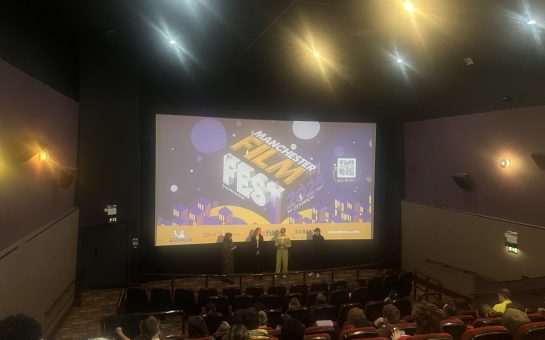Manchester’s annual horror film festival filled with ghosts, demons, monsters, rivers of blood and screeches got underway on Friday.
Based in the Odeon, Grimmfest is now in its seventh year, and is ranked in the top 40 worldwide genre film festivals.
Previous premières have included The Babadook, Sinister and What We Do In The Shadows, whilst a host of famous faces have attended in the past.
MM went down to the Printworks to check out some of this year’s offerings.
Cherry Tree
There’s always time to appreciate the gothic side of the horror genre, and Cherry Tree, premiering in the North on Friday at Grimmfest, is an amicable 90 minutes of dark visual imagery.
School girl Faith’s life takes a turn for the worse when her father is diagnosed with cancer, but her new hockey teacher seems to believe there is a way to cure him.
Little does Faith know, this will come at a hefty cost for her.
Positive things first; the idea behind the story arc is interesting, exploring the dynamics of a witchcraft cult and providing a moderately interesting take on resurrection and the art of sacrifice – much of the film revolves around one witch ranting away about nature’s fruits and the mixing of blood.
The use of imagery is quite interesting in places, combined with some all-out gory mayhem in the final act, and some extravagant make-up.
These positive features would enhance the film’s strength, if its production values did not sadly let it down from becoming a classic cult film.
The production predominantly comes across as tacky and cheap – most of the visual effects that aren’t modelled or practical really do show the limited budget the film had.
The dialogue is almost laughably bad. It contains a lot of people glaring at each other and stating the obvious about what’s going on, there’s nothing creative in it outside of the witchcraft monologues.
The film’s leading lady, Naomi Battrick, lacks conviction. She appears to remain detached throughout the entire story – she doesn’t seem too bothered that her dad is dying or a witch has betrayed her. There’s one tear shed, but that’s as far as it goes.
It’s far from terrible, and it will pass as a mildly interesting horror distraction, but as a whole, the limited production values and lack of a strong cast weighs it down from reaching the heights of other budget cult hits.
Turbo Kid
When one hears of a ‘parody’ film, it’s hard to resist the temptation to exhale deeply and brace yourself for an awful excuse for a piece of cinema.
Thankfully, Turbo Kid is the rare nostalgic treat that gets the trashy, self-deprecating humour bang on.
Munro Chambers stars as The Kid, a comic-book loving adolescent making his own path through an apocalyptic wasteland on his BMX, who after his enthusiastic friend is kidnapped by a tyrannical overlord, dons the persona of his favourite hero to rescue her.
The film is a budget cult homage to two key franchises.
Mad Max is the most prominent, the lone wolf idea is translated to a teen, and respects are paid to the Terminator notion of humanoid robots.
While the film has all the visual and aesthetic features of a budget production, it uses this to its advantage, as it plays out the parody whilst laughing at itself in the process.
To call it a ‘dumb’ film may work for some, but there’s more to it than just messing around with ideas from previous franchises.
It mocks its own silliness and exaggeration, making the audience laugh at it and how exuberant it’s being.
The film also mashes its tone throughout, and pulls off some of the most inventive blood splatters and gory techniques that die-hard fans could want.
Michael Ironside, having the time of his life playing the tyrant Zeus, tears his role up.
Over the top and pantomime, he is fully aware of his lack of dramatic heft, and, just like the film, encourages the audience to laugh at him.
Whilst it won’t be for those wanting something deeply cinematic, Turbo Kid provides the laughs, the blood and the underlying sense of ‘we’re just here to have fun and mess around with franchise clichés’.
And after ten minutes, you’re totally on board with that.
The Nightmare
The Nightmare is the second documentary feature to come from director Rodney Ascher, well-known for his first offering Room 237, which focussed on Stanley Kubrick’s The Shining.
It explores eight people’s stories on their sufferings of sleep paralysis – the inability of a person to move or talk just before they fall asleep, whilst experiencing terrifying hallucinations.
The subject matter itself is extremely interesting, and Ascher’s approach to it is very matter-of-fact.
The film doesn’t portray a viewpoint of the stories people are telling, but showing them exactly how they tell them, using sets and actors to recreate what the people experienced.
This factual approach to the stories allows for a lot of audience interpretation, which, when concerning subject matter as dark as this, is the right way to go forward.
There will be a tendency for many viewers who do not have any time for religious explanations of the supernatural to simply dismiss the stories as mental hallucinations, dreams and nightmares.
Others may be more open minded into what happens to those who suffer paralysis.
The documentary’s efforts to visually recreate every detail of the hallucinations described in the interviews may polarise some viewers.
Some may want to see a full visual representation to fully comprehend the terror and suffering the people go through, so as to determine what they really think is going on.
Others, who are more interested in the authentic, real-life scares of the subject, may have just wanted the in-depth interviews to be shown, with pencil drawings of what they saw.
This approach could have been beneficial, as when the people are being interviewed, some of the details they describe are spine-tinglingly chilling.
You can argue for and against the approach the documentary uses, but fundamentally that’s the point it’s trying to make.
It presents its findings exactly the way they have been researched, showing the visions of the volunteers, and detailing what their opinion of it is, and doesn’t give an opinion itself.
It’s up to audiences to decide what they believe, but the documentary does a solid job of providing detailed research into the matter.
Click here for part two of MM’s guide to Grimmfest.
Image courtesy of Zero Media, via Youtube, with thanks.



